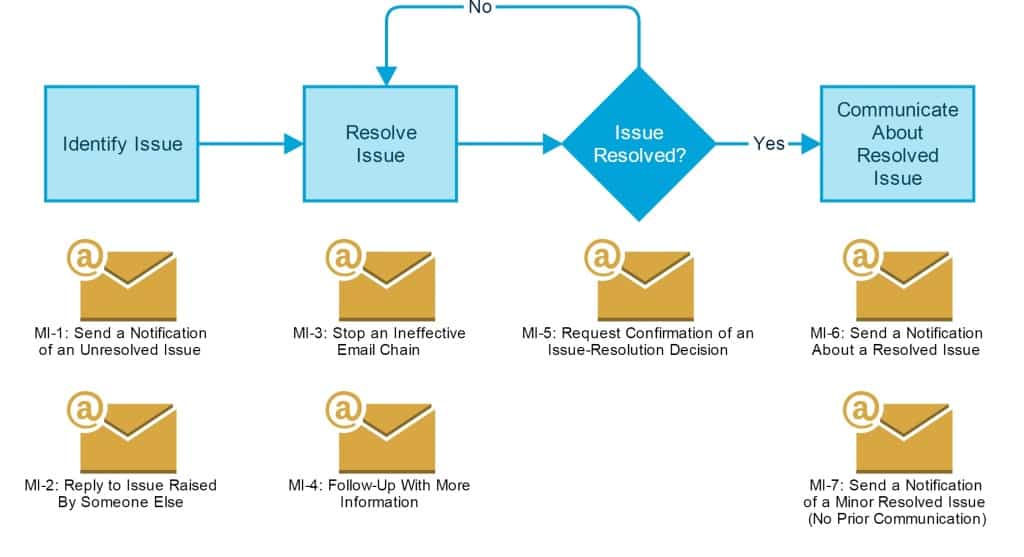Today we’re wrapping up our series going into a little more detail on the things I would have liked to have known before I started my business analyst career with an article about how to manage requirements issues professionally.
Taking ownership of the issues that naturally come up as part of the requirements process prevents unnecessary drama and enables the entire team to stay focused on working through the most important requirements first.
By methodically communicating about new issues, the work you are doing to resolve issues, and when an issue is resolved, you’ll be able to actively manage the issues that naturally surface during the requirements process in a professional way.
Here’s a quick visual map you can use to remember what pieces of communication to send about the issues that come up on your projects.

Click here to download this visual map in PDF format and save it for future use. You also might want to check out our Email Communication Templates for copy-and-paste email templates covering each of the scenarios discussed here.
Now, let’s go through some quick tips for each aspect of managing issues.
Identify an Issue
When you identify a new project issue, you can use email to send a clear description of the issue, the potential impact, and the steps you are taking to resolve it. By communicating early, you get in front of the issue and get to frame it, potentially in a more positive way than someone else would.
What’s more, you aren’t just signaling the alarm. You are also demonstrating that you’ve taken ownership of moving the resolution process forward.
You can take a similar approach when someone else raises a new issue via email. These email chains can get a little messy. By replying and taking ownership of the issue, you’ll prevent unnecessary drama.
Resolve Issue
Most likely the work you do to resolve the issue will not happen via email – you’ll be facilitating meetings, analyzing options, and doing research.
However, email is an important communication tool to keep stakeholders in the loop. If the issue is a visible one, it may be necessary to update key stakeholders as you move through the resolution process with more information and next steps.
What’s more, even while you are using virtual or face-to-face collaboration methods to resolve the issue, a team member may try to resolve all or part of the issue via email. Once a few emails are unsuccessful at closing things off, you’ll want to stop the back and forth from distracting everyone by sending an email letting everyone know you’ll be organizing a meeting to collaborate on the topic at hand.
Communicate About a Resolved Issue
Finally, once an issue is resolved, you’ll want to communicate the end result to all interested stakeholders.
One way to elevate yourself and take more control over the requirements process is to make more decisions and recommendations when it comes to how to resolve issues. For example, instead of sending an email with three options and asking the sponsor to choose one, send an email briefly summarizing the three options your team considered, recommend one option, and seek input only if the sponsor disagrees with the decision.
Other times, there may be only one viable resolution and in this case you simply need to communicate what’s being done to resolve the issue.
In still other cases, you may identify and resolve a smaller issue in the course of your work, but find it prudent to share the decision process with a wider group. For example, if you identify a requirement change that has a minor impact and are able to confirm with the developer that it can be incorporated without a schedule delay, you may opt to jump right to the final stage of the process by sending out an informative notification.
A Quick Synopsis
A constant stream of new and resolved issues is to be expected as part of the requirements process. Professional business analysts take ownership of issues, the work being done to resolve them, and the decision-making process to ensure that issues do not become distractions.
Start with Trusted Email Templates for Managing Issues

Click here to learn more about the Email Communication Templates
